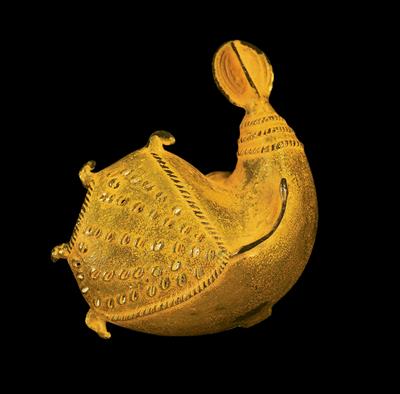Ashanti, Ghana: A gold finger ring depicting a catfish.

Gold was always very prevalent in Ghana and in the bordering regions. The region was formerly known as the ‘Gold Coast.’ Gold dust, washed out of rivers, was a common form of currency there. It was weighed using so-called gold-weights (see also cat. no. 22). The king of the Ashanti, called 'Asantehene', wore gold crowns and rich gold ornaments. He was carried in a golden litter, and in his great court, most of the objects were inlaid and decorated with gold: statues, sceptres, stately rods - even the sandals. Also the ‘national sanctuary’ of the Ashanti, the ‘Golden Chair’ (upon which nobody may sit) is a stool, richly appointed with gold. The present finger ring, in the form of a naturally represented fish, a catfish, gives an impression of the formerly wealthy ‘gold culture’ of the Ashanti: finely wrought, with eyes, wide mouth, beard and fins. Executed with ‘waste mould’ casting and worked with engraving. The ring is made of 13 karat gold and weighs 12 grams. Dimensions: 5.2 cm x 3.7 cm (the fish); DM 1.5 x 2.3 cm (the circlet of the ring). First half to mid-20th century. (ME)
Provenance: Austrian Private Collection.
Esperto: Prof. Erwin Melchardt
 Prof. Erwin Melchardt
Prof. Erwin Melchardt
+43-1-515 60-465
erwin.melchardt@dorotheum.at
02.11.2015 - 14:00
- Prezzo realizzato: **
-
EUR 1.250,-
- Prezzo di partenza:
-
EUR 1.000,-
Ashanti, Ghana: A gold finger ring depicting a catfish.
Gold was always very prevalent in Ghana and in the bordering regions. The region was formerly known as the ‘Gold Coast.’ Gold dust, washed out of rivers, was a common form of currency there. It was weighed using so-called gold-weights (see also cat. no. 22). The king of the Ashanti, called 'Asantehene', wore gold crowns and rich gold ornaments. He was carried in a golden litter, and in his great court, most of the objects were inlaid and decorated with gold: statues, sceptres, stately rods - even the sandals. Also the ‘national sanctuary’ of the Ashanti, the ‘Golden Chair’ (upon which nobody may sit) is a stool, richly appointed with gold. The present finger ring, in the form of a naturally represented fish, a catfish, gives an impression of the formerly wealthy ‘gold culture’ of the Ashanti: finely wrought, with eyes, wide mouth, beard and fins. Executed with ‘waste mould’ casting and worked with engraving. The ring is made of 13 karat gold and weighs 12 grams. Dimensions: 5.2 cm x 3.7 cm (the fish); DM 1.5 x 2.3 cm (the circlet of the ring). First half to mid-20th century. (ME)
Provenance: Austrian Private Collection.
Esperto: Prof. Erwin Melchardt
 Prof. Erwin Melchardt
Prof. Erwin Melchardt
+43-1-515 60-465
erwin.melchardt@dorotheum.at
|
Hotline dell'acquirente
lun-ven: 10.00 - 17.00
kundendienst@dorotheum.at +43 1 515 60 200 |
| Asta: | Tribal Art |
| Tipo d'asta: | Asta in sala |
| Data: | 02.11.2015 - 14:00 |
| Luogo dell'asta: | Wien | Palais Dorotheum |
| Esposizione: | 28.10. - 02.11.2015 |
** Prezzo d’acquisto comprensivo dei diritti d’asta acquirente e IVA
Non è più possibile effettuare un ordine di acquisto su Internet. L'asta è in preparazione o è già stata eseguita.
